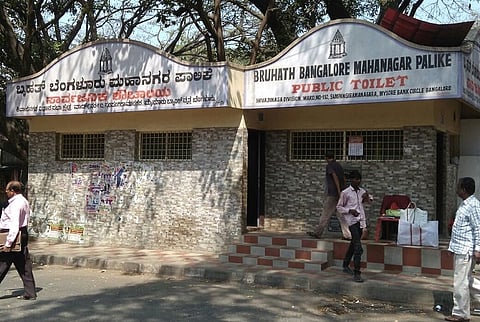

The bustling metropolis of Bengaluru which has been projected as the Silicon Valley of India has recently got bad press with incidents of flooding with little rain or death due to pothole ridden roads.
Now, a survey done by a city-based nonprofit has found that the IT capital of the country is short by more than a thousand (1,100) public toilet complexes, according to the Swachh Bharat (Clean India) Guidelines— the flagship scheme introduced by the PM Modi-led BJP government.
The survey done by Janaagraha with support from The Asia Foundation found out that the city is serviced by 2,838 public toilet seats across 473 public toilet complexes.
According to the 2011 census, 8.4 crore people live in Bengaluru permanently while unofficial estimates say that the current population is about 120 million. Moreover, Bengaluru has a floating population of 5 lakh people.
The Swachh Bharat guidelines prescribe one toilet seat per 100 men and two per 100 women and at least one toilet complex every seven km stretch. The survey revealed that there is a toilet for every 24 km stretch on an average.
But all is not bad. The survey found that the Bruhat Bengaluru Mahanagara Palike has done a good job in areas with high pedestrian traffic.
In fact, in 43 out of the total 198 wards, the BBMP has built more or the required number of mandated toilets. However, 64 wards did not have any public toilets at all.
“The best performing ward is Sudhama Nagara with 28 toilet complexes, followed by Dharmaraya Swamy temple ward with 22 toilet complexes,” Janaagraha said in a statement. A total of 473 toilet complexes were physically surveyed.
But in 10 wards with 11 major bus depots, there are no public toilets at all, the survey found.
The location of wards was found to be an important factor. Almost 85% of the existing toilet complexes are located in inner wards. But even then, 42 of the inner wards which house an estimated 61% of the city’s population do not have toilets.
How clean and accessible are the toilets?
The survey found three toilet complexes in the city to score a perfect 10 when it comes to cleanliness and accessibility. These are at Pattabhiram Nagar, Bharathi Nagar and Attiguppe. Of the three, one is maintained by the BBMP while the other two are maintained by private contractors.
Shockingly, only 10% of male and 6% of female toilets have functional flushes, resulting in unhygienic conditions which pose a health hazard.
Less than half (47%) of the toilets had clean floors and only close to 60% of the toilets had sufficient lighting.
Dustbins were found only in 13% of the men’s toilets and 12% in women’s. 63% of men’s toilets had washbasins while 58% of the women’s toilets did not have wash basins.
Overall, toilets maintained under the PPP model (Public Private Partnership) fared better than ones maintained by the BBMP itself.
What can the BBMP do to improve the situation?
Janagraha suggests that the BBMP makes petrol pumps open their toilets to the public as is the case on National Highways.
They have further added that the BBMP should also try to build toilets in parks and playgrounds if there is adequate space available as it would reduce the cost of buying land.
Deploying portable toilets in strategic locations is another suggestion.